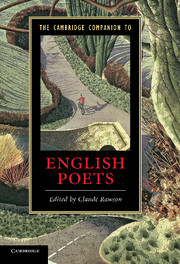Book contents
- Frontmatter
- Introduction
- 1 Geoffrey Chaucer
- 2 Thomas Wyatt
- 3 Edmund Spenser
- 4 William Shakespeare
- 5 John Donne
- 6 Ben Jonson
- 7 George Herbert
- 8 John Milton
- 9 Andrew Marvell
- 10 John Dryden
- 11 Jonathan Swift
- 12 Alexander Pope
- 13 William Blake
- 14 Robert Burns
- 15 William Wordsworth
- 16 Samuel Taylor Coleridge
- 17 George Gordon, Lord Byron
- 18 Percy Bysshe Shelley
- 19 John Keats
- 20 Alfred Lord Tennyson
- 21 Robert Browning
- 22 Emily Brontë
- 23 Christina Rossetti
- 24 Thomas Hardy
- 25 William Butler Yeats
- 26 D. H. Lawrence
- 27 T. S. Eliot
- 28 W. H. Auden
- 29 Philip Larkin
- Further Reading
- Index
7 - George Herbert
Published online by Cambridge University Press: 28 May 2011
- Frontmatter
- Introduction
- 1 Geoffrey Chaucer
- 2 Thomas Wyatt
- 3 Edmund Spenser
- 4 William Shakespeare
- 5 John Donne
- 6 Ben Jonson
- 7 George Herbert
- 8 John Milton
- 9 Andrew Marvell
- 10 John Dryden
- 11 Jonathan Swift
- 12 Alexander Pope
- 13 William Blake
- 14 Robert Burns
- 15 William Wordsworth
- 16 Samuel Taylor Coleridge
- 17 George Gordon, Lord Byron
- 18 Percy Bysshe Shelley
- 19 John Keats
- 20 Alfred Lord Tennyson
- 21 Robert Browning
- 22 Emily Brontë
- 23 Christina Rossetti
- 24 Thomas Hardy
- 25 William Butler Yeats
- 26 D. H. Lawrence
- 27 T. S. Eliot
- 28 W. H. Auden
- 29 Philip Larkin
- Further Reading
- Index
Summary
The date 1633 is a significant one in the history of English poetry. In that year, two remarkable collections of verse were published posthumously: the poems of John Donne, and The Temple by George Herbert. Donne was well known in his lifetime as a distinguished preacher and Dean of St Paul’s Cathedral; he is now widely admired for his witty love-poetry, dynamic satires, and religious verse and prose. Herbert, by contrast, ended his life in relative obscurity as the rector of a rural parish near Salisbury, and some modern readers may have assigned him an equivalent place in the landscape of English poetic achievement. Since his verse output consisted of just one modest book containing nothing but devotional poetry, does Herbert’s work really deserve to be placed alongside that of the other major names celebrated in this volume? This essay, not surprisingly, will answer that question with a resounding affirmative.
My aim is to demonstrate the greatness of Herbert’s poetry by focusing on four key features of his work, each of which is discussed in general terms and explored in one representative poem. While Herbert’s volume of verse consists of three main parts – ‘The Church-porch’, ‘The Church’ and ‘The Church Militant’ – it is the lyric poems in the extensive middle section that are now most frequently read and acclaimed. These will form the basis of the following celebration of Herbert’s poetry, the ‘utmost art’ which he himself offered in praise of God.
‘I resolved to be bold’: plainness and profundity
- Type
- Chapter
- Information
- The Cambridge Companion to English Poets , pp. 139 - 153Publisher: Cambridge University PressPrint publication year: 2011
- 1
- Cited by

